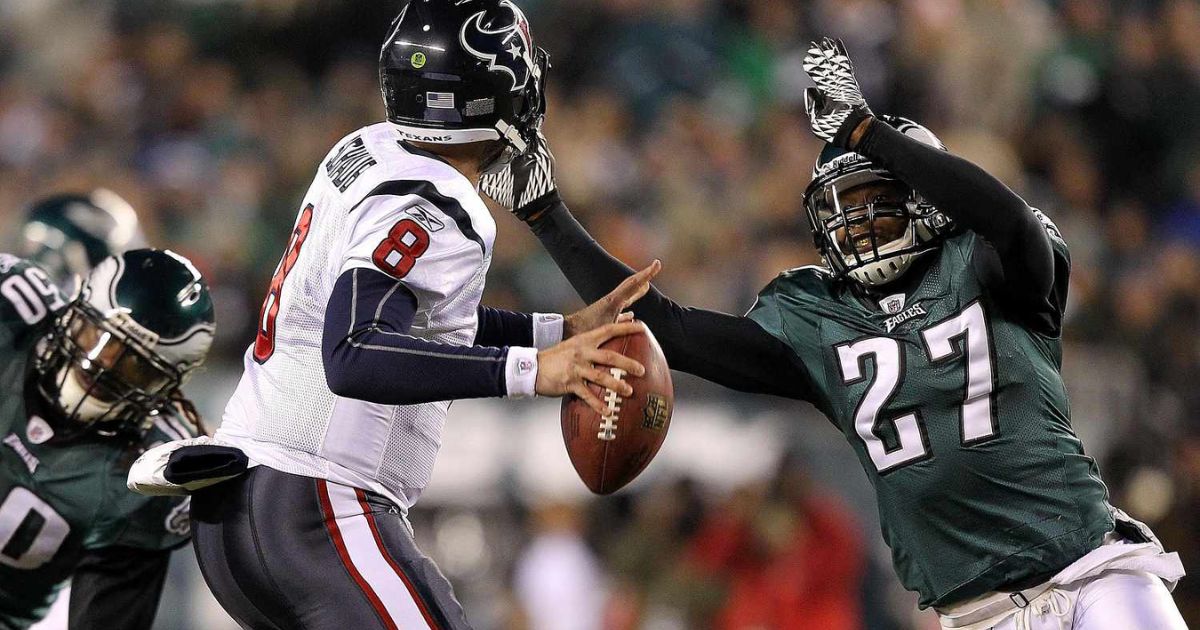Football’s a game of strategy, and few plays pack as much punch as the blitz. Whether you’re a die-hard fan or just getting into the sport, understanding the blitz can take your appreciation of the game to a whole new level.
In this guide, we’re going to break down everything you need to know about this game-changing defensive tactic. From its basics to advanced strategies, we’ll cover it all. So, grab your playbook and let’s dive into the thrilling world of the blitz!
What is the blitz?
The blitz is like a surprise party for the quarterback, but instead of confetti, it’s a bunch of fired-up defenders. At its core, a blitz is when the defense sends more players than usual to rush the quarterback or disrupt the backfield. It’s a high-risk, high-reward play that can turn the tide of a game in seconds.
The term “blitz” comes from the German word “blitzkrieg,” meaning lightning war. Just like its namesake, a football blitz is fast, aggressive, and aims to overwhelm the opponent quickly. Teams use the blitz to pressure the quarterback, force quick decisions, and hopefully cause turnovers or big losses for the offense. It’s a chess move in a game of physical chess, where timing and execution are everything.
How many players is a blitz?
When it comes to blitzing, numbers matter. A standard defensive front usually rushes four players, typically the defensive linemen. Anything more than that is considered a blitz. You might see five, six, or even seven players charging towards the backfield like a stampede of angry bulls.
The more players you send on a blitz, the higher the stakes. Send too many, and you might leave receivers wide open for big gains. Send too few, and the offense might pick up the blitz easily. It’s all about finding that sweet spot.
Some of the most memorable blitzes in NFL history have come from teams who mastered this balance. Take the 1985 Chicago Bears, for example. Their “46 Defense” was essentially a continuous blitz that terrorized offenses and led them to a Super Bowl victory.
How do Coaches use the Blitz?
Coaches use the blitz like a secret weapon, pulling it out at just the right moment to catch the offense off guard. It’s not just about sending players; it’s about when and how you send them. A well-timed blitz can be the difference between a game-winning sack and giving up a touchdown. The defensive coordinator plays a crucial role in blitz plays.
They’re like the conductor of a very aggressive orchestra, deciding when to dial up the pressure and from where. Blitzes fit into the overall defensive scheme like pieces of a puzzle. Sometimes they’re used to stop a running play, other times to rattle a quarterback who’s getting too comfortable. The best coaches know how to mix up their blitzes to keep the offense guessing and off-balance all game long.
What are the types of blitzes?
Blitzes come in all shapes and sizes, each with its own flavor of chaos. Let’s break down some of the most common types you’ll see on the field. Remember, knowing these can make you feel like a real football genius when watching the game!
Zone Blitz
The zone blitz is like a magic trick on the football field. One second, a linebacker’s rushing the quarterback; the next, he’s dropped back into coverage while a defensive end takes his place. This switcheroo can confuse the offense and create mismatches. It’s a clever way to bring pressure without leaving the secondary exposed.
Safety Blitz
When a safety blitzes, it’s like unleashing a secret weapon. Safeties are usually the last line of defense, so when they come charging in, it can catch the offense by surprise. This blitz can be devastating if timed right, but it also leaves a big hole in the deep part of the field. It’s a gamble that can pay off big or backfire spectacularly.
Cornerback Blitz
The cornerback blitz is all about speed and surprise. Corners are usually covering receivers, so when they blitz, it often goes unnoticed until it’s too late. This blitz can be especially effective against roll-out passes or when the offense is focused on protecting against pressure up the middle. It’s like a sneak attack from the edge of the battlefield.
Zero Blitz
The zero blitz is the “all-in” of football defenses. It means sending everyone except those covering receivers, leaving no deep defenders. It’s incredibly risky but can completely shut down a play if it works. Coaches usually save this for critical moments, like third and long situations or when they’re confident the offense is going to run the ball.
Run Blitz
While most blitzes target the quarterback, the run blitz aims to stuff the running back before he can even get started. Defenders crash specific gaps, trying to penetrate the backfield and tackle the runner for a loss. It’s particularly effective against teams with strong running games, but can leave the defense vulnerable to play-action passes if they guess wrong.
How does an offense beat the blitz?
Beating the blitz is all about preparation and quick thinking. Offenses have several tools in their arsenal to counter aggressive defenses. Let’s look at some of the most effective ways teams try to turn the tables on blitzing defenders.
Quick Passes
The fast track to beating a blitz is often through the air. Quick passes, like slants or screens, can take advantage of the gaps left by blitzing defenders. Quarterbacks and receivers need to be on the same page, reading the defense and adjusting routes on the fly. It’s like a game of speed chess, where the offense tries to outsmart the defense before they can reach the backfield.
Mobile Quarterbacks
A quarterback who can move is like kryptonite to a blitzing defense. Mobile QBs can slip away from pressure, buy time for receivers to get open, or even take off running if everyone’s covered. Think of players like Lamar Jackson or Patrick Mahomes, who can turn a potential sack into a big gain with their legs. Their ability to escape pressure often makes defenses think twice before sending extra blitzers.
Max Protection
Sometimes, the best defense against a blitz is a good offense… or in this case, more blockers. Max protection schemes keep extra players in to block, giving the quarterback more time to find open receivers downfield. It’s like building a fortress around the QB. The trade-off is fewer receivers running routes, but against heavy blitzes, it can provide the time needed to hit a big play.
Conclusion
The blitz is a game-changer in football. It’s a risky but powerful move that can turn the tide of a game in seconds. From zone blitzes to all-out attacks, each type has its own strengths and weaknesses. Smart coaches use blitzes like secret weapons, keeping offenses on their toes.
But the blitz isn’t unstoppable. Quick passes, mobile quarterbacks, and solid protection can all beat a blitz. It’s this back-and-forth that makes football so exciting. Next time you watch a game, keep an eye out for blitzes. You’ll see the chess match unfold right before your eyes.










